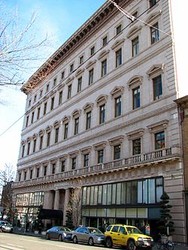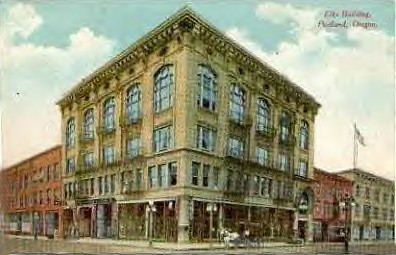Elks Temple
Introduction
Text-to-speech Audio
Images
Elks Temple today (wikimedia commons)

Elks Temple, postcard date unknown (rootsweb.ancestry.com)

Backstory and Context
Text-to-speech Audio
More than three thousand eight hundred Elks members existed in Portland during its peak, and in 1921 a purpose built temple was required to meet the demands of their growing membership. Architects Houghtaling & Dougan were commissioned to design the meeting hall for the society. They began construction in December 1922, and it was completed in December the following year at a cost of more than one million dollars.
The Portland Elks Temple was designed in a late 19th and 20th century Revivalist style. An elevator provided access to the upper floors. The structure contained a gymnasium and swimming pool for the Elks members, in addition to a seven thousand five hundred square foot ballroom embellished with Corinthian columnns on the fourth floor. A dining room and additional, smaller ballroom were located on the third floor, the former of which was decorated with comical frescoes of former Elks members. Most of the Elks’ activities occurred on the second floor of the building; financial matters were handled in the Vault Room, whilst female visitors to the building were allowed to access only the Fireside Room on the west side of the floor. There was also a beautiful library on the second story, with a splendid coffered ceiling decorated gold-leaf. A room nearby was used for billiards, and another for playing cards, the latter being decorated with a frieze depicting a “Chippendale Chinese” dragon and a magnificent tiled floor depicting every card in a deck. The Billiard Room was similarly decorated, with a plaster frieze of tropical plants, winged cobras, and birds of paradise. Of all the rooms in the structure, however, the so-called Lodge Room is the most enigmatic. It contained a bar made of Black marble, arches and spiralling columnns, and ornate plasterwork depicting birds and male faces (likely those of former Elks members).
The building was used by the Elks society until only 1932, when membership sharply declined as a result of the stock market crash three years earlier. The Portland Elks announced their bankruptcy in 1932, and were forced to leave the building. It remained vacant for a number of years, until the Works Progress Administration occupied it in 1939. During the Second World War it was used as the Oregon Recruitment Office for the U.S. Army. It also contained a number of athletics clubs. A building was once more left vacant from 1959 until extensive renovations began in 1973. It was renamed as the Princeton Building in 1985, from which point it was used as an office building.
The Elks Temple is located in the west wing of the Governor Hotel. Formerly known as the Seward Hotel (it was renamed in 1932), the earliest part of this building was erected in 1909, designed by William Christmas Knighton. The building has a splendid fusion of Early Modern and Arts and Crafts architectural styles, inspired by that found in Vienna, Austria Of particular note are the massive stained glass dome (restored and renovated in 1990) and the unusual architectural embellishments used on top of the building, which have been described as anthropomorphic “robots”. In 1992 the Elks Temple was joined with the Governor Hotel when the latter was being enlarged.
The Elks Temple has experienced much internal and external modification throughout its existence, reflecting the changing functions of the structure. Three mezzanines were added during renovations in the early 1980s. Some parts of the exterior of the former Elks Temple changed during the merger in the 1990s. The top two floors of the old Elks Temple were converted into one hundred hotel rooms, including twelve penthouse suites. During these renovations the old Heritage Ballroom was rediscovered on the fourth floor, which had been obscured by the offices that were established in the 1980s. In 2004 the main entrance was moved to the façade of the Elks building from its former position on the Governor building, and one decade later the lettering was restored above the main entrance.
